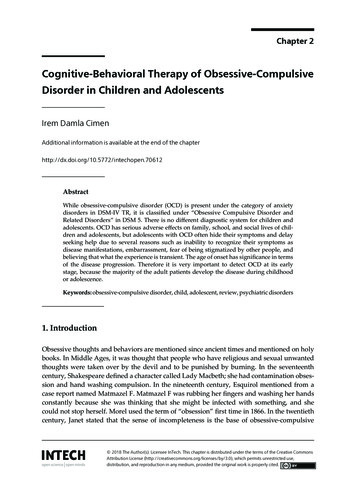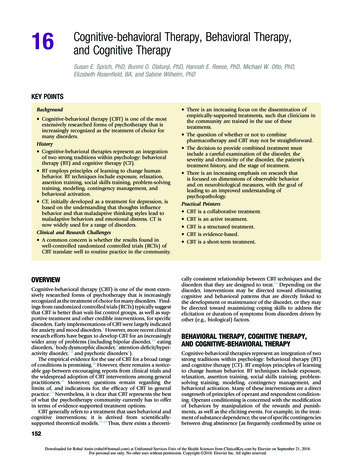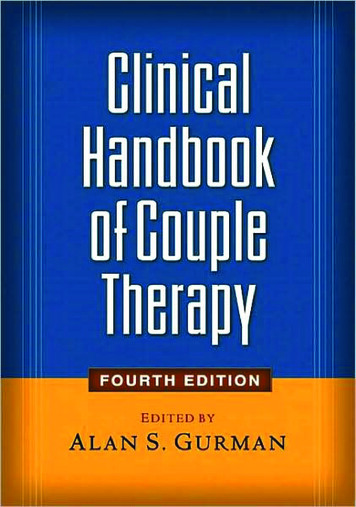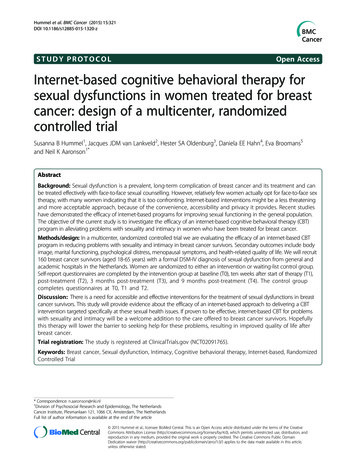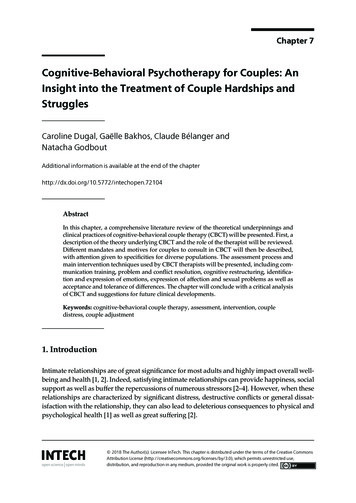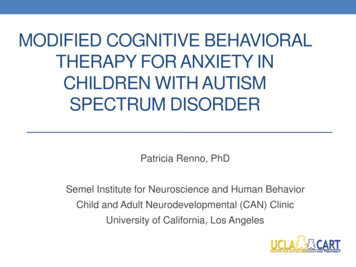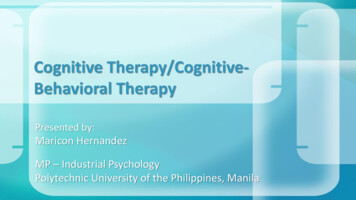
Transcription
Cognitive Therapy/CognitiveBehavioral TherapyPresented by:Maricon HernandezMP – Industrial PsychologyPolytechnic University of the Philippines, Manila
Aaron Beck Born on July 18, 1921 Cognitive schema(underlyingbeliefs/patterns ofthoughts) Automatic thoughts Cognitive distortions(inaccurate thoughts)(Neukrug, 2010)Photo Source: uphs.upenn.edu
Cognitive ional,behavioral,physiological)One’s thoughts influence one’semotion and behavior (Beck J., 2011)
Example:Several people are reading a basic text on cognitive therapy.Reader A thinks: “Thisreally makes sense. Finally,a book that will reallyteach me to be a goodtherapist!” Reader A feelsmildly excited and keepsreading.Credits: VectorToons and Vector-ImagesReader B, on the otherhand, thinks Thisapproach is too simplistic.It will never work.”Reader B feelsdisappointed and closesthe book.
Example:Several people are reading a basic text on cognitive therapy.Reader C has the followingthoughts: “This book isn’twhat I expected. What awaste of money.” ReaderC is disgusted and discardsthe book altogether.”Credits: VectorToons and Vector-ImagesReader D thinks, “I reallyneed to learn all this. Whatif I don’t understand it?What if I never get good atit?” Reader D feels anxiousand keeps reading the samefew pages over and over.
Example:Several people are reading a basic text on cognitive therapy.Reader E has different thoughts: “This is just too hard. I’mso dumb. I’ll never master this. I’ll never make it as atherapist.” Reader E feels sad and turns on the television.Credits: VectorToons and Vector-Images
Beliefs (core beliefs) – just the way things“are”; regarded by the person as absolutetruths (Beck, 1987, Beck, 2011 ).
TREATMENT OVERVIEWDeveloping therapeuticrelationshipPlanning treatment andstructuring sessionsEmphasizing thepositvePhoto Credits: Google imagesIdentifying andresponding todysfuntional cognitionsFacilitating cognitive aswell as behavioralchange.
TREATMENT SESSIONSIntake/Evaluation Session Greet the patient. Collaboratively decide with the patientwhether a family member should attend all,part, or none of the session. Conduct the assessment. Set initial broader goals. Elicit feedback from the patient.
Between Evaluation and FirstTherapy Session Write up evaluation report/initialcognitive conceptualization plan andinitial treatment plan. Hypothesize about the developmentof patient’s disorder. Use conceptualization to developbraod treatment plan.
First Therapy Session Initial Part of Session 1: Set the agenda, doa mood check, obtain an update (since theevaluation), discuss patients’ diagnosis &psychoeduaction Middle Part of Session 1: Identify problemsand set goals, educate the patient about thecognitive model, discuss a problem End of Session 1: provide or elicit summary,review homework assignment, elicitfeedback
Commonly-used Cognitive Therapy Techniques1. Thought Stopping2. Imagery changing Following images to completion Jumping ahead of time Coping in the image Changing the image
Reality –testing the image Repeating the image Image stopping Image Distracting3. Rational Emotive Role Play4. Behavioral and Emotive Techniques
Session 2 and Beyond Initial Part of Session: Do a mood check, setthe agenda, obtain an update reviewhomework, prioritize the agenda Middle Part of Session: Work on specificproblem and teach cognitive behaviortherapy skills in that context, follow-updiscussion w/ relevant, collaborativelyhomework assignments, work on a secondproblem. End of Session: provide or elicit summary,review homework assignment, elicitfeedback
3. TerminationAs the therapy continues, the therapist should expectclient setbacks as the client struggles to work on hisor her problems and as the hypotheses that wereformed become slightly changed.As the client nears the last session, the therapistshould explore his or her thoughts about terminationand help client develop a process in which he/she isconducting self-management sessions.
What is a therapy session like?(Beck, 2011)1. At the beginning of sessions, establish therapeuticalliance, check on patient’s mood symptoms, andexperiences in the past week, and ask them to namethe problems they most want help in solving.2. Review the self-help activities (homework or actionplans) patients engaged in since the previous session.3. Then in the context of discussing a specific problempatients have put on the agenda, you will collect dataabout the problem, cognitively conceptualize thepatients’ difficulties, and collaboratively plan astrategy.
Developing as a Cognitive TherapistStage 1: Learn the basic skills in conceptualizing a case incognitive terms based on the intake evaluation and datacollected in session.Stage 2: Become more proficient in integratingconceptualization with knowledge of the techniques. Selecting Timing Implementing appropriate techniquesStage 3: More automatically integrate new data into tehconceptualization
References:Beck, J. (2011). Cognitive Behavior Therapy Basics andBeyond. New York. Guilford PressFlanagan, J. & Flanagan, R. (2012). Counseling andPsychotherapy Theories: In Context and Practice NewJersey.John Wiley & Sons Inc.Neukrug E. (2010). Counseling Theory and Practice.Virgina.Cenggage Learning
Thank you!
problem and teach cognitive behavior therapy skills in that context, follow-up discussion w/ relevant, collaboratively homework assignments, work on a second problem. End of Session: provide or elicit summary, review homework assignme
